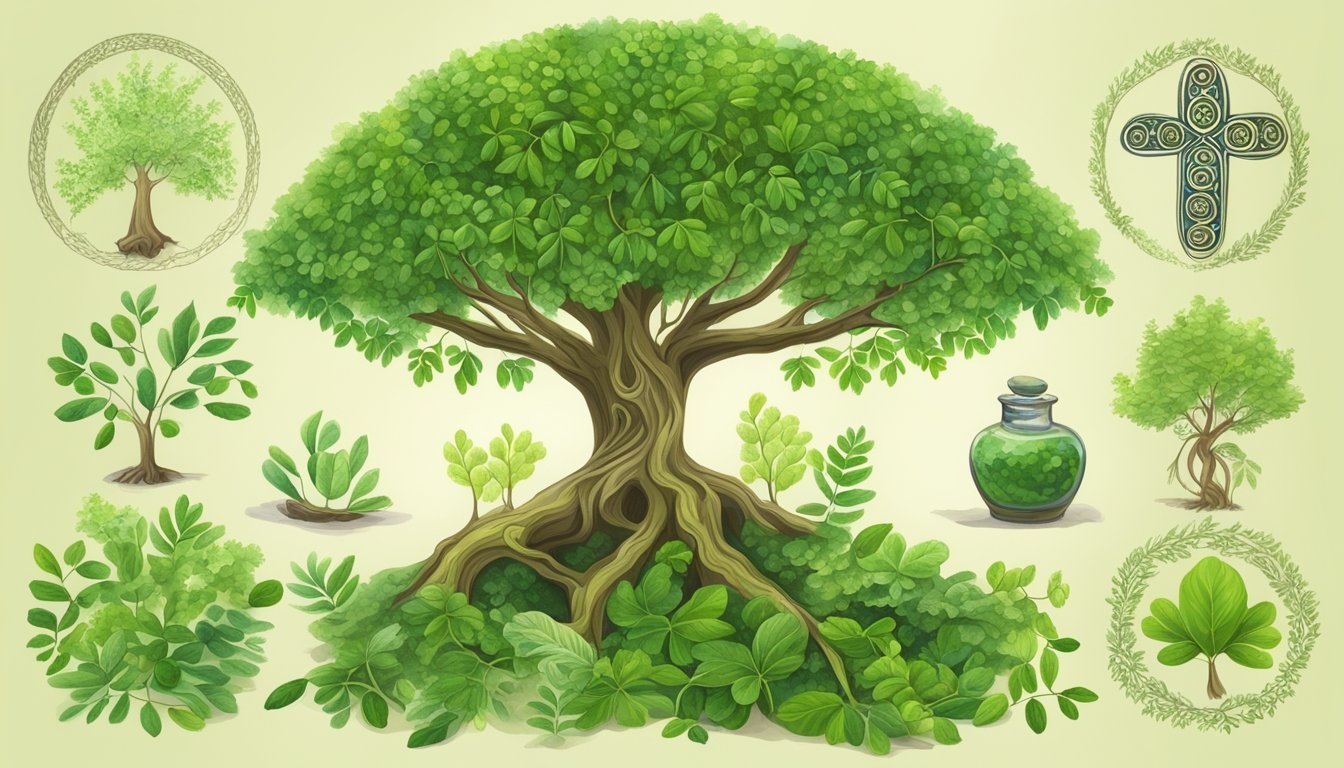Moringa
The Miracle Tree Known by Ancient Cultures and Modern Science
Moringa Oleifera, often hailed as the "Miracle Tree," is a plant with a rich heritage in traditional medicine and is deeply rooted in the wisdom of ancient cultures. Its history extends back to the Ancient civilizations of India, where it was greatly valued for its myriad of health benefits and medicinal properties. Revered for its resilience and rapid growth, the Moringa tree is native to the Indian subcontinent, particularly flourishing in the southern foothills of the Himalayas.
The tree's utility is prolific, with nearly every part of the plant being used for health-related purposes. Moringa has been traditionally employed to treat a wide range of ailments, from wounds and ulcers to more complex conditions like liver disease, heart disease, and diabetes. Its high content of nutrients and antioxidants, including quercetin and chlorogenic acid, contributes to its reputation as a nutritional powerhouse, supporting its use in alleviating malnutrition and various health disorders.
Moringa, a nutritional powerhouse, has gained widespread recognition for its potential health benefits and versatile uses. This remarkable plant has been an integral part of traditional wellness practices, valued for its ability to promote overall well-being. When combined with seaweed, cinnamon, and cranberries, moringa offers a holistic approach to supporting health, reflecting its enduring appeal in ancient and modern wellness traditions.
Furthermore, the addition of valerian, shea butter, and nuts and seeds further complements the health-promoting potential of moringa, contributing to its reputation as a versatile and effective natural remedy. Additionally, the incorporation of dates into dietary and wellness practices alongside moringa has expanded the spectrum of potential health benefits, underscoring the enduring appeal of this remarkable plant.
In conclusion, moringa continues to be celebrated for its positive impact on nutrition and vitality, offering a natural solution for promoting overall well-being. Whether used in dietary supplements, culinary creations, or wellness tonics, moringa remains a symbol of wellness and natural health practices, embodying a rich heritage of traditional wellness and nutritional wisdom.
Historical Significance
The Moringa tree has a storied legacy rooted in ancient practices and traditional medicine across various cultures. This section explores its historical significance, shedding light on how the ancient Egyptians and societies in Africa and Asia harnessed the Moringa's properties.
Moringa in Ancient Egypt
In Ancient Egypt, Moringa oil was a cherished product, valued for its hydrating and skin-protecting qualities. It was commonly applied to the skin, not only to maintain its youthful appearance but also for the embalming of the dead. Pharaohs were entombed with jars of Moringa oil, which suggests it was considered a valuable item to accompany them into the afterlife.
Traditional Uses in Africa and Asia
Across Africa and Asia, traditional uses of Moringa have been varied and extensive. The leaves, seeds, and pods have been incorporated into local medicine systems for centuries.
Africa:
Nutrition: Leaves were used as nutritional supplements.
Medicine: Seeds served as an anti-inflammatory and pain relief; pods were utilized for digestive issues.
Water purification: Seeds also played a critical role in purifying water.
Asia:
India: Considered an essential herbal plant, Moringa leaves and seeds were used to treat ailments like ulcers, liver disease, heart disease, and cancer.
Anti-inflammatory properties: The tree's various parts provided relief from inflammation.
In both continents, Moringa has been deeply integrated into local practices and is a testament to the ancient wisdom surrounding natural wellness solutions.
Botanical Overview
This section provides a detailed exploration of Moringa Oleifera, a plant revered for its versatility in cultivation and array of varieties.
Understanding Moringa Oleifera
Moringa Oleifera, commonly referred to as the "drumstick tree," belongs to the family Moringaceae. It is a fast-growing, drought-resistant tree native to the Indian subcontinent, but it thrives in various tropical and subtropical regions globally. This deciduous tree generally reaches a height of between 5 to 10 meters, and in some cases, it can grow up to 15 meters. It has a light, feathery canopy composed of drooping branches and tripinnate leaves. The Moringa tree is notable for its clusters of fragrant, five-petaled flowers and elongated seed pods, which house oil-rich seeds.
Preferred Soils: The plant adapts to a wide range of soil types, but it flourishes best in sandy or loamy soils with good drainage. It shows remarkable resilience in arid environments, often where other plants struggle to survive.
Varieties and Cultivation
There are thirteen species within the genus Moringa, with Moringa Oleifera being the most widely cultivated. This tree species has garnered attention for its easy propagation and rapid growth rate.
Cultivation Practices:
Seeding: Moringa Oleifera is typically propagated by seeds or cuttings.
Spacing: Adequate space between plants is crucial to ensure sufficient light and airflow, promoting optimal growth.
Water: While drought-tolerant, regular watering during the initial growth phase supports better establishment.
Maintenance: Minimal care is necessary; however, occasional pruning encourages bushier growth and higher leaf production.
Cultivation of Moringa Oleifera is not only practical due to its hardiness in arid and suboptimal soil conditions, but also sustainable, as it provides a renewable source of nutrition and other benefits.
Nutritional Composition
Moringa oleifera, with its extensive nutritional profile, is a key source of vitamins, minerals, proteins, amino acids, antioxidants, and polyphenols.
Vitamins and Minerals Content
Moringa leaves are a significant source of essential vitamins and minerals. They are particularly high in vitamin A, which is crucial for vision, immune function, and skin health. Vitamin C is abundant in the leaves as well, surpassing the amounts found in oranges and supporting overall immune system function. The leaves are also a good source of vitamin E, which acts as a potent antioxidant. In terms of minerals, moringa is rich in calcium and potassium, necessary for bone health and blood pressure regulation respectively. Iron, important for preventing anemia, is present in notable quantities.
Vitamin A: ___ mcg/100g
Vitamin C: ___ mg/100g
Vitamin E: ___ mg/100g
Calcium: ___ mg/100g
Potassium: ___ mg/100g
Iron: ___ mg/100g
Protein and Amino Acids
The protein content in moringa is quite impressive, especially for a plant. Moringa contains all nine essential amino acids, making it a complete protein source, a rarity among plants. Essential amino acids, such as leucine, valine, and isoleucine, are critical for muscle growth and repair, while others like tryptophan are important for neurotransmitter synthesis.
Protein: ___g/100g
Leucine: ___ mg/100g
Isoleucine: ___ mg/100g
Tryptophan: ___ mg/100g
Antioxidants and Polyphenols
Antioxidants are abundant in moringa leaves, which contain various compounds with antioxidant properties, such as beta-carotene, quercetin, and chlorogenic acid. These substances can neutralize harmful free radicals and may reduce the risk of chronic diseases. Polyphenols like kaempferol and rutin also contribute to the antioxidant effects and support general health.
Beta-carotene: ___ mcg/100g
Quercetin: ___ mg/100g
Chlorogenic Acid: ___ mg/100g
Kaempferol: ___ mg/100g
Rutin: ___ mg/100g
The measurement provided in the form of ___ is intended to be substituted with specific nutritional values based on verified data or standard nutritional databases.
Health Benefits
Moringa oleifera, widely recognized for its nutritional value and medicinal properties, offers a range of health benefits that have been leveraged in traditional medicine systems across the globe. This section delves into the specifics of how Moringa contributes to general well-being, disease prevention, and the management of various health conditions.
General Well-being and Nutrition
Moringa is a nutrient-dense plant, rich in vitamins A, C, and E, as well as minerals like calcium and potassium. It is an excellent source of protein, containing all nine essential amino acids, which is uncommon for a plant. This makes it particularly beneficial for individuals seeking plant-based sources of nourishment.
Nutrients:
Vitamins: A, C, E
Minerals: Calcium, Potassium
Amino acids: All nine essential
Disease Prevention and Treatment
The tree's leaves, seeds, and seedpods are known for their antioxidant properties, which can help in preventing cell damage and reducing the risk of chronic diseases. Regular consumption of Moringa may contribute to heart health by maintaining optimal blood pressure and cholesterol levels. Furthermore, its anti-inflammatory properties aid in the management and prevention of conditions like arthritis.
Antioxidant benefits: Prevents cell damage
Heart health: Supports blood pressure and cholesterol control
Anti-inflammatory: Assists in arthritis management
Effects on Specific Health Conditions
Studies suggest that Moringa possesses antimicrobial and hepatoprotective qualities, which respectively support the body's infection-fighting capabilities and liver health. Its impact on blood sugar levels is also noteworthy, with evidence indicating potential benefits for individuals with diabetes. Research into Moringa's effects on cancer is ongoing, with some findings pointing towards its possible use in cancer prevention and support during treatment.
Antimicrobial: Enhances the body's defense against infections
Hepatoprotective: Promotes liver health
Diabetes: Helps in managing blood sugar levels
Cancer: Potential role in cancer prevention and treatment
Moringa as Food and Medicine
Moringa, a tree revered for its nutrient-rich parts, serves both as a robust food source and a traditional medicinal plant. Recognized for its versatility, every part of the moringa tree is utilized in culinary applications and in medicinal practices, supported by contemporary research.
Culinary Uses
Moringa leaves are a staple in many diets, especially within communities close to its native regions. Rich in vitamins and minerals, the leaves can be eaten raw, cooked, or ground into powder form to enrich dishes such as soups and sauces. Here are its common culinary uses:
Fresh Leaves: Used in salads or as garnishes.
Cooked Leaves: Incorporated into main dishes like curries or stews.
Leaf Powder: Added to smoothies, teas, or as a supplement.
Moringa in Traditional Medicine
In Ayurvedic practices, moringa is a well-known entity with a history spanning thousands of years. It has been employed as an antibiotic and antibacterial agent to treat infections and a remedy for a variety of conditions, including:
Wounds and ulcers: To promote healing.
Liver disease and heart disease: As a supportive treatment.
Inflammation: To reduce symptoms.
Contemporary Medicinal Research
Recent clinical studies have begun to validate the longstanding medicinal claims surrounding moringa. Its high antioxidant properties, attributed to compounds like flavonoids and ascorbic acid, contribute to its effectiveness against oxidative stress. Moringa leaves, both in tea form and supplements, are currently under investigation for these potential benefits:
Antioxidant activity: To combat free radicals.
Anti-inflammatory effects: For potential use in disease management.
Antimicrobial properties: In exploring natural antibiotic alternatives.
Researchers continue to explore moringa’s full spectrum of health benefits through rigorous scientific study.
Side Effects and Safety
While Moringa is celebrated for its potential health benefits, individuals should remain aware of the side effects and safety regarding its consumption. The following information outlines observed adverse reactions and guidelines on dosage and administration to ensure safe use.
Potential Adverse Reactions
Moringa consumption may lead to a range of side effects, although they are generally rare when consumed in moderations natural to a diet. Side effects can include:
Allergic Reactions: Symptoms such as itching or rashes may occur.
Gastrointestinal Disturbances: Ingesting Moringa might lead to nausea, diarrhea, or heartburn.
Lower Blood Pressure: Caution is advised for individuals with hypotension, as Moringa might exacerbate the condition.
Interactions with Medications: It can potentially interact with medications, particularly those for diabetes and high blood pressure, by enhancing their effects.
Appropriate Dosage and Administration
The optimal dosage of Moringa varies depending on the form of Moringa:
Leaves: Fresh or dried leaves can be used in amounts typical for greens.
Powder: A common dosage is 1-2 teaspoons per day.
Seed Oil: Often administered topically; no standard internal dosage.
When considering the administration of Moringa, it should be gradually introduced into the diet to monitor tolerance and should not be consumed in excessive quantities. It is crucial that pregnant and breastfeeding women avoid Moringa due to a lack of research on its safety in these populations. Always consult healthcare providers before starting any new supplement, especially for individuals with pre-existing health conditions or those taking other medications.
Agricultural and Environmental Aspects
Moringa oleifera, commonly recognized for its agricultural value and minimal environmental impact, is a drought-resistant species that plays a crucial role in sustainable development. It is a species that thrives even in harsh climatic conditions, making it an asset in farming practices aimed at land regeneration and food security.
Farming Practices and Harvest
Moringa oleifera is typically cultivated in semi-arid, tropical, and subtropical regions, owing to its robust nature. Farmers cultivate it through direct seeding or branch cuttings, with harvest cycles depending on the plant part desired—leaves, seeds, fruits, roots, or stems.
Leaves: Usually harvested by hand several times per year.
Seeds and Fruits: Harvested when the pods become brown and dry, which occurs once annually.
Roots and Stems: Harvested as needed, with caution, as it can affect the plant's longevity.
Moringa's Role in Sustainable Development
Moringa’s contribution to sustainable development is multifaceted:
Agriculture: The cultivation of Moringa oleifera aids in improving soil fertility and provides leaves that serve as nutritious fodder for livestock.
Drought Resistance: Its drought-resistant nature makes it a key species in arid regions, ensuring continuous production despite water scarcity.
Environmental Impact: As a fast-growing tree, moringa helps in carbon sequestration, combating soil erosion, and can be integrated into agroforestry systems to support biodiversity.
By optimizing harvest techniques and leveraging Moringa oleifera's resilient properties, communities can establish sustainable agricultural practices with a positive environmental impact.
Cosmetic and Industrial Uses
Moringa oleifera's byproducts, particularly its seed oil, have gained prominence in the cosmetic industry due to their beneficial properties for skin and hair care. The leaf powder is also recognized for its application in various industrial domains.
Moringa in Skin and Hair Care
Skin: The antioxidants and moisturizing properties of Moringa leaf powder are useful in skin care formulations. It can help reduce fine lines and wrinkles, improving the overall appearance of the skin. Additionally, its anti-inflammatory properties make it beneficial in treating skin conditions and maintaining overall skin health.
Hair: Moringa leaf powder and Moringa seed oil are also beneficial for hair care products. They are rich in vitamins and minerals that nourish the scalp, strengthen hair, and promote healthy hair growth. These properties make them popular ingredients in shampoos and conditioners.
Moringa Seed Oil Applications
Moringa seed oil is highly valued for its unique properties. It is used in:
Lubrication: Due to its high oleic acid content, it is used as a lubricant in fine machinery, including timepieces.
Perfumery: The Romans and Egyptians historically valued Moringa seed oil for its pleasant fragrance and incorporated it into their perfumes.
Skin Protection: Its hydrating and emollient qualities make it a protective agent against skin-damaging elements, a use that dates back to Egyptian times.
Global Impact and Cultural Significance
The Moringa tree, recognized worldwide for its nutritional and medicinal benefits, has profoundly influenced various cultures and continues to be a subject of modern scientific research, cementing its role in global sustainability efforts and health initiatives.
Moringa's Influence in Different Cultures
Moringa oleifera, commonly hailed as the "Tree of Life," has been intertwined with the traditional medicine practices of India for centuries. Its use in Ayurvedic medicine is extensive, often utilized to treat over 300 conditions. In parts of Africa, various parts of the plant serve as vital sources of nutrition. In the UK, moringa has garnered attention due to its wide range of potential health benefits and is increasingly incorporated into dietary supplements and health foods.
India: Ancient use in Ayurveda, valued for treating multiple ailments.
Africa: Integral to diet and medicine, often used to combat malnutrition.
UK: Interest in moringa as a superfood, integrated into health and wellness products.
Modern Perceptions and Research
Scientific research has reinforced the cultural significance of moringa by exploring its potential to address contemporary global challenges, such as malnutrition and sustainability. Studies conducted across various countries have looked into its nutritive profile, including rich contents of vitamins, minerals, and antioxidants, and its efficacy in treating certain conditions. Globally, moringa is recognized for its potential in supporting food security and aiding in the fight against malnutrition, while its fast-growing and drought-resistant nature makes it a candidate for environmental sustainability efforts.
Nutritional research: High vitamin and mineral content validated by modern science.
Medical research: Efficacy in treating specific health conditions under investigation.
Sustainability and food security: Contributions to combating malnutrition and promoting environmental sustainability recognized globally.










